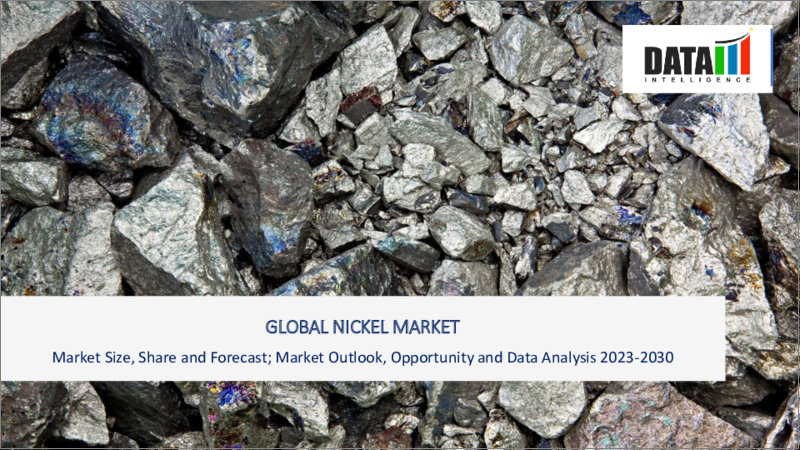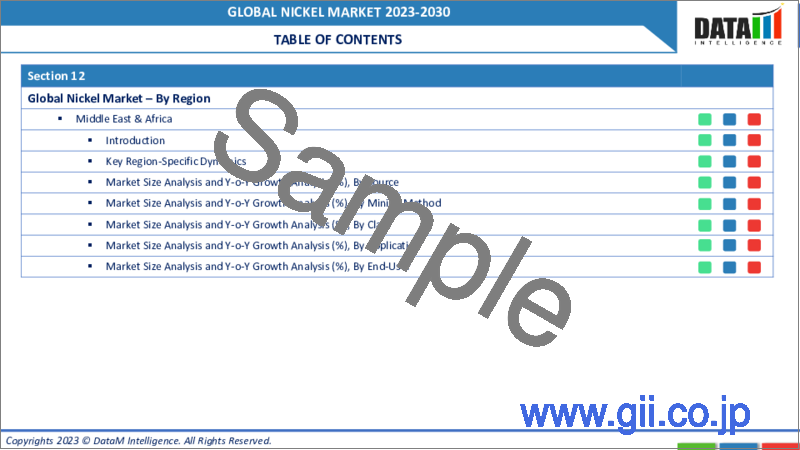|
|
市場調査レポート
商品コード
1325380
ニッケルの世界市場-2023年~2030年Global Nickel Market - 2023-2030 |
||||||
カスタマイズ可能
適宜更新あり
|
|||||||
| ニッケルの世界市場-2023年~2030年 |
|
出版日: 2023年08月04日
発行: DataM Intelligence
ページ情報: 英文 205 Pages
納期: 即日から翌営業日
|
- 全表示
- 概要
- 目次
市場概要
世界のニッケル市場は、2022年に336億米ドルに達し、2023~2030年の予測期間中にCAGR 5.5%で成長し、2030年には472億米ドルに達すると予測されます。バッテリーにおけるニッケル需要の増加は、より高いエネルギー密度と貯蔵容量をより安価に提供するのに役立ち、これが市場拡大の主な要因となっています。電気自動車の普及が進んでいることや、医療分野でのニッケル利用が拡大していることも、将来的なチャンスとなりそうです。
ステンレス鋼用途は、予測期間中、世界のニッケル市場の約35.4%を占めると予想されます。ステンレス鋼は耐食性、耐久性に優れ、広く利用できるため、飲食品、建設、航空宇宙など様々な産業で利用され、市場拡大を牽引しています。
市場力学
ステンレス鋼製品におけるニッケル需要の拡大
ステンレス鋼はニッケルの主要な最終用途であり、世界のニッケル市場のかなりの割合を占めています。経済成長、都市化、インフラ整備を原動力とするステンレス鋼製造の増加は、ニッケル需要に直接的な影響を与えています。ニッケルを含む鋼合金の人気が高まっています。ニッケル含有鋼種は、ステンレス鋼製造のかなりの部分を占めています。
タイプ316の11%、タイプ304の8%というニッケル濃度は、この鋼を溶接しやすく、延性があり、頑丈なものにしています。そのような耐食性、豊富な入手可能性と耐久性などの優れた機能のおかげで、ステンレス鋼の項目は、高い需要があります。ステンレス鋼は、航空宇宙、化学、石油・ガス、建設、自動車などの主要産業で広く使用されています。ニッケルは、鋼の製造に非常に不可欠であり、その生産に重要な合金のシェアを持っています。
成長する電気自動車と電池のエコシステム
電気自動車の生産と販売の増加は、リチウムイオンバッテリーの部品として多用されるニッケルの需要を押し上げると思われます。電気自動車の生産台数の増加は、自動車メーカーが電池の生産を加速させているため、ニッケルの需要を増大させています。インドの素材会社イプシロン・アドバンスト・マテリアルズは2023年6月、米国で新たな電池材料生産を開発するために6億5,000万米ドルを投資すると発表しました。
ニッケルの高いエネルギー貯蔵能力はEVの航続距離の延長に貢献し、EVの性能を向上させる重要な材料となっています。現在進行中の電池技術研究は、リチウムイオン電池のエネルギー密度の向上と低コスト化を目指しています。電池性能を向上させるために、NMC(ニッケル-マンガン-コバルト)やNCA(ニッケル-コバルト-アルミニウム)などのニッケルリッチ正極が採用されています。
環境への懸念とステンレス鋼産業への依存
ニッケル鉱石の採掘と加工は、生息地の破壊、水質汚染、温室効果ガスの排出など、環境に悪影響を及ぼす可能性があります。環境上の制約が増え、持続可能性に対する懸念が高まると、コンプライアンスコストが増加し、特定のニッケル源へのアクセスが制限されます。ステンレス鋼産業はニッケルの主要な消費国で、ニッケル消費量のかなりの割合を占めています。
ニッケルの需要が単一の産業に依存しているため、ニッケル市場はステンレス鋼の需要や生産の変動に左右される可能性があります。金属リサイクルや代替材料の技術進歩は、特定の用途における新たなニッケル生産需要を低下させ、ニッケル市場全体に影響を与える可能性があります。
COVID-19影響分析
需要の混乱とサプライチェーンの問題の結果、ニッケルの在庫水準が変動しました。ニッケルの購入を制限した結果、在庫が増加した業界もあれば、サプライチェーンの混乱の結果、不足に陥った業界もあります。鉱業や加工施設の安全衛生慣行が変更されました。この変更は、生産量、作業員の能力、操業効率に影響を及ぼしました。
BHPは銅の最大予想生産量を14万トン、ニッケルの予想生産量を1万トン引き下げました。さらに、リオ・ティントは2021年、労働力不足とサプライチェーンの問題から、老朽鉱山に代わる新規プロジェクトの着手を試みており、困難な年明けとなっています。3月期の鉄鉱石生産量は前年同期比で8%減少したことを明らかにしました。
ロシア・ウクライナ紛争の影響
紛争の地域的な影響は、周辺の国や地域、特にロシアとウクライナの双方と密接な関係にある欧州とアジアのニッケル需要と供給の動きに影響を与える可能性があります。その地域のニッケル生産と供給に影響を与え、世界の供給不足につながる可能性があります。地政学的な懸念は、世界のニッケル市場の安定性に対する投資家の心理や市場の認識に影響を与える可能性があります。
ウクライナ紛争を受けてニッケル価格が高騰し、適切な条件が整えば、エネルギー転換に向けたサプライチェーンの課題が提起されます。ニッケルはリチウムイオン電池に少量使用されるため、EVは安定した供給を必要とします。電池に使用される量が少ないにもかかわらず、価格変動が続けば、電気自動車の価格が最大1,000米ドル上昇する可能性があります。
目次
第1章 調査手法と調査範囲
第2章 定義と概要
第3章 エグゼクティブサマリー
第4章 市場力学
- 影響要因
- 促進要因
- 電気自動車と電池のエコシステムの成長
- ステンレス鋼製品におけるニッケル需要の拡大
- 抑制要因
- 高コストと価格変動
- 環境への懸念とステンレス鋼産業への依存
- 機会
- 影響分析
- 促進要因
第5章 産業分析
- ポーターのファイブフォース分析
- サプライチェーン分析
- 価格分析
- 規制分析
第6章 COVID-19分析
第7章 供給源別
- ペントランダイト
- ラテライト
第8章 採掘方法別
- 地下
- 地表
第9章 クラス別
- ニッケルクラスI
- 電解ニッケル
- 粉体・ブリケット
- カルボニルニッケル
- ニッケルクラスII
- ニッケル銑
- フェロニッケル
第10章 用途別
- ステンレス鋼
- 合金
- 鉄合金
- 非鉄合金
- メッキ
- 鋳造
- 電池
- その他
第11章 エンドユーザー別
- 金属製品
- 電気・電子
- エンジニアリング
- 建築・建設
- 運輸
- その他
第12章 地域別
- 北米
- 米国
- カナダ
- メキシコ
- 欧州
- ドイツ
- 英国
- フランス
- イタリア
- ロシア
- その他欧州
- 南米
- ブラジル
- アルゼンチン
- その他南米
- アジア太平洋
- 中国
- インド
- 日本
- オーストラリア
- その他アジア太平洋
- 中東・アフリカ
第13章 競合情勢
- 競合シナリオ
- 市況/シェア分析
- M&A分析
第14章 企業プロファイル
- Glencore
- 会社概要
- 製品ポートフォリオと説明
- 財務概要
- 最近の動向
- Vale SA
- Eramet SA
- Sherritt International Corp.
- Sumitomo Metal Mining Co.
- Anglo American
- MMC Norilsk Nickel
- Jinchuan Group Ltd.
- BHP Billiton Ltd
- Pacific Metal Company
第15章 付録
Market Overview
Global Nickel Market reached US$ 33.6 billion in 2022 and is expected to reach US$ 47.2 billion by 2030, growing with a CAGR of 5.5% during the forecast period 2023-2030. The growing demand for nickel in batteries aids in the delivery of higher energy density and more storage capacity at a cheaper cost, which is the primary driver of market expansion. The rising adoption of electric vehicles, as well as the developing use of nickel in the medical field, are likely to present opportunities in the future.
Stainless steel application is anticipated to account for around 35.4% of the global nickel market during the forecast period. Owing to its corrosion resistance, durability and widespread availability, stainless steel is utilized in a variety of industries, including food and beverage, construction and aerospace, among others, driving market expansion.
Market Dynamics
Growing Demand of Nickel in Stainless Steel Products
Stainless steel is a major end-use of nickel, accounting for a sizable percentage of global nickel market. The rise in stainless steel manufacturing, driven by economic growth, urbanization and infrastructural development, has a direct impact on nickel demand. Nickel-containing steel alloys have become increasingly popular. Nickel-containing grades account for a significant portion of stainless steel manufacture.
Nickel concentration of 11% in type 316 and 8% in type 304 make the steel easily weldable, ductile and robust. Owing to its superior features such as corrosion resistance, plentiful availability and durability, stainless steel items are in high demand. Stainless steel is widely used in major industries such as aerospace, chemical, oil and gas, construction, automotive and others. Nickel is very essential in the manufacturing of steel and has a significant alloy share in its production.
Growing Electric Vehicles and Batteries Ecosystem
The increased production and sales of electric vehicles will drive up demand for nickel, which is largely utilized as a component in lithium-ion batteries. The increase of electric vehicle production has increased nickel demand as automobile manufacturers speed up battery production. Epsilon Advanced Materials, an Indian materials company, announced a US$ 650 million investment in June 2023 to develop a new battery materials production in U.S.
Nickel's high energy storage capacity contributes to longer EV ranges, making it an important material for improving EV performance. Ongoing battery technology research aims to improve the energy density and lower the cost of lithium-ion batteries. To enhance the battery performance, nickel-rich cathodes such as NMC (nickel-manganese-cobalt) and NCA (nickel-cobalt-aluminum) chemistries are being employed.
Environmental Concerns and Dependance on Stainless Steel Industry
Nickel ore mining and processing can have negative environmental consequences such as habitat damage, water pollution and greenhouse gas emissions. Increasing environmental constraints and concerns about sustainability increases the compliance costs and restrict access to certain nickel sources. The stainless steel industry is a major consumer of nickel, accounting for a sizable share of nickel consumption.
Dependance of nickel demand on a single industry can impose the nickel market to variations in stainless steel demand and production. Technological advances in metal recycling and substitute materials may lower demand for new nickel production in specific applications, affecting the overall nickel market.
COVID-19 Impact Analysis
Nickel inventory levels fluctuated as a result of demand disruptions and supply chain problems. Some industries restricted their nickel purchases, resulting in greater stocks, while others experienced shortages as a result of supply chain disruptions. It caused modifications in mining and processing facilities' health and safety practices. The changes had an effect on output, worker capacity and operational efficiency.
BHP lowered its maximum anticipated copper output by 140,000 tonnes and its anticipated nickel output by 10,000 tonnes. In addition, Rio Tinto has had a difficult start to the year in 2021, attempting to put on new projects that will replace aged mines because to labor shortages and supply chain issues. It revealed that iron ore output fell 8% in the March quarter compared to the same period last year.
Russia- Ukraine War Impact
The regional consequences of the conflict may have an impact on nickel demand and supply dynamics in surrounding nations and regions, particularly in Europe and Asia, which have close relations with both Russia and Ukraine. It impacted the nickel production and supply in the regions, possibly leading to worldwide supply shortages. Geopolitical concerns can have an impact on investor sentiment and market perception of the global nickel market's stability.
Soaring nickel prices have surged in response to the Ukraine conflict, posing supply chain challenges for the energy transition if the correct conditions exist. Because nickel is utilized in small amounts in lithium-ion batteries, EVs require a consistent supply. Despite the small quantities used in the batteries, continued price volatility could increase the price of electric vehicles by up to US$ 1,000.
Segment Analysis
The global nickel market is segmented based on source, mining method, class, application, end-user and region.
Rising Penetration of EVs Drives the Batteries Segment
Batteries is expected to hold about 1/4th of the global nickel market and grow at a significant rate during the forecast period 2023-2030. The growing demand for electric vehicles is primarily driving the nickel market in the automotive industry. High purity nickel derived from sulfide nickel is mostly used in EV batteries.
As per the Society of Manufacturers of Electric Vehicles, sales of electric two-wheelers have more than doubled to 2,33,971 units in 2021 from 1,00735 units in 2020. Owing to its high energy in electric vehicles, it will aid in increasing the usage of nickel for lithium-ion batteries and steel alloys within the automotive sector. Thus, the demand for nickel will rise due to rising contributions from electric vehicle batteries, stainless steel automobile components and other applications during the forecast period.
Geographical Analysis
Presence of Large Steel Manufacturing Companies in Asia-Pacific
Asia-Pacific is anticipated to have the highest CAGR in the global nickel market during the forecast period 2023-2030. The existence of significant stainless-steel manufacturing enterprises and battery manufacturers is mostly to blame. The major nickel ore concentrations in Philippines, Australia, Indonesia and China have helped the region to become the leading nickel producer.
U.S. Geological Survey estimates that Indonesia has the world's greatest nickel reserve, with a mining reserve of 21 million metric tons in 2021. Furthermore, the mining reserves of the Philippines, China and Australia total 28.6 million metric tons. Furthermore, the growing use of nickel in electric vehicles (EVs) is likely to increase the regional industry, since it accounts for a major portion of nickel demand.
Competitive Landscape
The major global players include Glencore, Vale SA, Eramet SA, Sherritt International Corp., Sumitomo Metal Mining Co., Anglo American, MMC Norilsk Nickel, Jinchuan Group Ltd., BHP Billiton Ltd and Pacific Metal Company.
Why Purchase the Report?
- To visualize the global nickel market segmentation based on source, mining method, class, application, end-user and region, as well as understand key commercial assets and players.
- Identify commercial opportunities by analyzing trends and co-development.
- Excel data sheet with numerous data points of nickel market-level with all segments.
- PDF report consists of a comprehensive analysis after exhaustive qualitative interviews and an in-depth study.
- Product mapping available as Excel consisting of key products of all the major players.
The global nickel market report would provide approximately 77 tables, 80 figures and 205 Pages.
Target Audience 2023
- Manufacturers/ Buyers
- Industry Investors/Investment Bankers
- Research Professionals
- Emerging Companies
Table of Contents
1. Methodology and Scope
- 1.1. Research Methodology
- 1.2. Research Objective and Scope of the Report
2. Definition and Overview
3. Executive Summary
- 3.1. Snippet by Source
- 3.2. Snippet by Mining Method
- 3.3. Snippet by Class
- 3.4. Snippet by Application
- 3.5. Snippet by End-User
- 3.6. Snippet by Region
4. Dynamics
- 4.1. Impacting Factors
- 4.1.1. Drivers
- 4.1.1.1. Growing Electric Vehicles and Batteries Ecosystem
- 4.1.1.2. Growing Demand of Nickel in Stainless Steel Products
- 4.1.2. Restraints
- 4.1.2.1. High Costs and Volatility in Prices
- 4.1.2.2. Environmental Concerns and Dependence on Stainless Steel Industry
- 4.1.3. Opportunity
- 4.1.4. Impact Analysis
- 4.1.1. Drivers
5. Industry Analysis
- 5.1. Porter's Five Force Analysis
- 5.2. Supply Chain Analysis
- 5.3. Pricing Analysis
- 5.4. Regulatory Analysis
6. COVID-19 Analysis
- 6.1. Analysis of COVID-19
- 6.1.1. Scenario Before COVID
- 6.1.2. Scenario During COVID
- 6.1.3. Scenario Post COVID
- 6.2. Pricing Dynamics Amid COVID-19
- 6.3. Demand-Supply Spectrum
- 6.4. Government Initiatives Related to the Market During Pandemic
- 6.5. Manufacturers Strategic Initiatives
- 6.6. Conclusion
7. By Source
- 7.1. Introduction
- 7.1.1. Market Size Analysis and Y-o-Y Growth Analysis (%), By Source
- 7.1.2. Market Attractiveness Index, By Source
- 7.2. Pentlandite*
- 7.2.1. Introduction
- 7.2.2. Market Size Analysis and Y-o-Y Growth Analysis (%)
- 7.3. Laterite
8. By Mining Method
- 8.1. Introduction
- 8.1.1. Market Size Analysis and Y-o-Y Growth Analysis (%), By Mining Method
- 8.1.2. Market Attractiveness Index, By Mining Method
- 8.2. Underground*
- 8.2.1. Introduction
- 8.2.2. Market Size Analysis and Y-o-Y Growth Analysis (%)
- 8.3. Surface
9. By Class
- 9.1. Introduction
- 9.1.1. Market Size Analysis and Y-o-Y Growth Analysis (%), By Class
- 9.1.2. Market Attractiveness Index, By Class
- 9.2. Nickel Class I*
- 9.2.1. Introduction
- 9.2.2. Market Size Analysis and Y-o-Y Growth Analysis (%)
- 9.2.3. Electrolytic Nickel,
- 9.2.4. Powders & Briquettes
- 9.2.5. Carbonyl Nickel
- 9.3. Nickel Class II
- 9.3.1. Nickel Pig Iron
- 9.3.2. Ferronickel
10. By Application
- 10.1. Introduction
- 10.1.1. Market Size Analysis and Y-o-Y Growth Analysis (%), By Application
- 10.1.2. Market Attractiveness Index, By Application
- 10.2. Stainless Steel*
- 10.2.1. Introduction
- 10.2.2. Market Size Analysis and Y-o-Y Growth Analysis (%)
- 10.3. Alloys
- 10.3.1. Ferrous Alloys
- 10.3.2. Non-ferrous Alloys
- 10.4. Plating
- 10.5. Foundry
- 10.6. Batteries
- 10.7. Others
11. By End-User
- 11.1. Introduction
- 11.1.1. Market Size Analysis and Y-o-Y Growth Analysis (%), By End-User
- 11.1.2. Market Attractiveness Index, By End-User
- 11.2. Metal Goods*
- 11.2.1. Introduction
- 11.2.2. Market Size Analysis and Y-o-Y Growth Analysis (%)
- 11.3. Electric and Electronics
- 11.4. Engineering
- 11.5. Building & Construction
- 11.6. Transportation
- 11.7. Others
12. By Region
- 12.1. Introduction
- 12.1.1. Market Size Analysis and Y-o-Y Growth Analysis (%), By Region
- 12.1.2. Market Attractiveness Index, By Region
- 12.2. North America
- 12.2.1. Introduction
- 12.2.2. Key Region-Specific Dynamics
- 12.2.3. Market Size Analysis and Y-o-Y Growth Analysis (%), By Source
- 12.2.4. Market Size Analysis and Y-o-Y Growth Analysis (%), By Mining Method
- 12.2.5. Market Size Analysis and Y-o-Y Growth Analysis (%), By Class
- 12.2.6. Market Size Analysis and Y-o-Y Growth Analysis (%), By Application
- 12.2.7. Market Size Analysis and Y-o-Y Growth Analysis (%), By End-User
- 12.2.8. Market Size Analysis and Y-o-Y Growth Analysis (%), By Country
- 12.2.8.1. U.S.
- 12.2.8.2. Canada
- 12.2.8.3. Mexico
- 12.3. Europe
- 12.3.1. Introduction
- 12.3.2. Key Region-Specific Dynamics
- 12.3.3. Market Size Analysis and Y-o-Y Growth Analysis (%), By Source
- 12.3.4. Market Size Analysis and Y-o-Y Growth Analysis (%), By Mining Method
- 12.3.5. Market Size Analysis and Y-o-Y Growth Analysis (%), By Class
- 12.3.6. Market Size Analysis and Y-o-Y Growth Analysis (%), By Application
- 12.3.7. Market Size Analysis and Y-o-Y Growth Analysis (%), By End-User
- 12.3.8. Market Size Analysis and Y-o-Y Growth Analysis (%), By Country
- 12.3.8.1. Germany
- 12.3.8.2. UK
- 12.3.8.3. France
- 12.3.8.4. Italy
- 12.3.8.5. Russia
- 12.3.8.6. Rest of Europe
- 12.4. South America
- 12.4.1. Introduction
- 12.4.2. Key Region-Specific Dynamics
- 12.4.3. Market Size Analysis and Y-o-Y Growth Analysis (%), By Source
- 12.4.4. Market Size Analysis and Y-o-Y Growth Analysis (%), By Mining Method
- 12.4.5. Market Size Analysis and Y-o-Y Growth Analysis (%), By Class
- 12.4.6. Market Size Analysis and Y-o-Y Growth Analysis (%), By Application
- 12.4.7. Market Size Analysis and Y-o-Y Growth Analysis (%), By End-User
- 12.4.8. Market Size Analysis and Y-o-Y Growth Analysis (%), By Country
- 12.4.8.1. Brazil
- 12.4.8.2. Argentina
- 12.4.8.3. Rest of South America
- 12.5. Asia-Pacific
- 12.5.1. Introduction
- 12.5.2. Key Region-Specific Dynamics
- 12.5.3. Market Size Analysis and Y-o-Y Growth Analysis (%), By Source
- 12.5.4. Market Size Analysis and Y-o-Y Growth Analysis (%), By Mining Method
- 12.5.5. Market Size Analysis and Y-o-Y Growth Analysis (%), By Class
- 12.5.6. Market Size Analysis and Y-o-Y Growth Analysis (%), By Application
- 12.5.7. Market Size Analysis and Y-o-Y Growth Analysis (%), By End-User
- 12.5.8. Market Size Analysis and Y-o-Y Growth Analysis (%), By Country
- 12.5.8.1. China
- 12.5.8.2. India
- 12.5.8.3. Japan
- 12.5.8.4. Australia
- 12.5.8.5. Rest of Asia-Pacific
- 12.6. Middle East and Africa
- 12.6.1. Introduction
- 12.6.2. Key Region-Specific Dynamics
- 12.6.3. Market Size Analysis and Y-o-Y Growth Analysis (%), By Source
- 12.6.4. Market Size Analysis and Y-o-Y Growth Analysis (%), By Mining Method
- 12.6.5. Market Size Analysis and Y-o-Y Growth Analysis (%), By Class
- 12.6.6. Market Size Analysis and Y-o-Y Growth Analysis (%), By Application
- 12.6.7. Market Size Analysis and Y-o-Y Growth Analysis (%), By End-User
13. Competitive Landscape
- 13.1. Competitive Scenario
- 13.2. Market Positioning/Share Analysis
- 13.3. Mergers and Acquisitions Analysis
14. Company Profiles
- 14.1. Glencore*
- 14.1.1. Company Overview
- 14.1.2. Product Portfolio and Description
- 14.1.3. Financial Overview
- 14.1.4. Recent Developments
- 14.2. Vale SA
- 14.3. Eramet SA
- 14.4. Sherritt International Corp.
- 14.5. Sumitomo Metal Mining Co.
- 14.6. Anglo American
- 14.7. MMC Norilsk Nickel
- 14.8. Jinchuan Group Ltd.
- 14.9. BHP Billiton Ltd
- 14.10. Pacific Metal Company
LIST NOT EXHAUSTIVE
15. Appendix
- 15.1. About Us and Services
- 15.2. Contact Us






